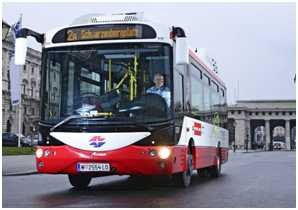Innovative Electric Buses in Vienna
An Urban Development Plan for 2025 has been established by the City of Vienna. As part of the plan, a sustainable transport policy has been put in place with the goal of reducing the amount of motorised transport by 20% by 2025. Therefore, the City is making significant changes and introducing a more sustainable transport system.

The challenge
The City of Vienna resolved to create a zero-emission zone in its historic centre. To achieve this, the City recognised the need to gradually replace all buses in this zone with zero-emission electric buses. The challenge for the City was to establish the necessary infrastructure to power the buses, i.e. linking Electric Vehicles to the grid.
The measure
The City of Vienna, Austria realised that in order to introduce more sustainable transport constructing new power lines and charging stations in the historic center would not be possible. The City therefore decided to avail of the preexisting extensive network of overhead power lines used by trams to charge the buses. This solution required the development of new technology
Wiener Linien, the company running the public transit network in Vienna and transporting over 900 million people in 2012, engaged in an extensive dialogue with the market in order to establish possible electric mobility solutions. Both a charger and an inverter were required components of the bus, as the tram power lines only supply direct current. This function had previously been unavailable on the market. As a result of their market research, Wiener Linien identified four models of buses, two of which were rejected during a testing phase due to their size or energy consumption. After the testing phase, Wiener Linien carried out a public procurement via an open tender for battery driven buses without diesel auxiliary power unit.
The contract was awarded to Siemens/Rampini, who offered the “ElectriCitybusse” capable of recharging at end stations by hooking up to the overhead tram lines using an arm on the roof referred to as an extendable pantograph. 12 of these buses have now been purchased.
The initial purchase price of each bus was twice the cost of a diesel bus of similar size. However, savings were made as the cost of electricity is substantially less than that of diesel. Additionally, the “ElectriCitybusse” have a smaller battery than a standard hybrid and electricity buses, making them lighter and less expensive to run.
Lessons learnt
The demand for this policy was created by the City of Vienna’s Urban Development Plan as well as the cities decision to create a zero-emission zone in the historic centre of the city. The success of this project was ensured by the market research and the extensive dialogue carried out. Wiener Linien won the national Austrian prize for mobility for this innovative procurement in 2013.
Further deployment
Wiener Linien has not yet extended their network of “ElectriCitybusse” but hope to purchase longer 12m buses in the future. Cities in both Europe and South America have expressed interest in adopting this innovative sustainable transport system, qualifying this policy for GML 8 on the maturity scale.
Website
